![]()
![]()
![]()
Use LEFT and RIGHT arrow keys to navigate between flashcards;
Use UP and DOWN arrow keys to flip the card;
H to show hint;
A reads text to speech;
38 Cards in this Set
- Front
- Back
|
About 75% of the lipids are (cholesterol? glycolipids? phospholipids?).
|
phospholipids
|
|
|
Because phospholipids have polar and nonpolar parts, they are said to be ____________.
|
Amphipathic
|
|
|
The polar part of a phospholipid molecule faces toward the (interior? surface?) of the membrane.
|
Surface
|
|
|
The polar parts are hydro-(philic? phobic?), meaning water-(/oving? fearing?).
|
philic, loving
|
|
|
About 20% of membrane lipids are (cholesterol? glycolipids? phospholipids?).
|
phospholipids
|
|
|
Glycolipids make up about __% of membrane lipids, and appear only in the layer that faces (extracellular? Intracellular?) fluid.
|
5, extracellular
|
|
|
(Lipid? Protein?) exhibit variety in structure and functions within different types of membranes.
|
Protein
|
|
|
Which type of membrane protein extends all the way across the membrane so is likely to be amphipathic? (Integral? Peripheral?)
|
integral
|
|
|
Which type of proteins are present on surfaces of membranes? (Integral? Peripheral?)
|
peripheral
|
|
|
Some integral proteins serve as receptors for chemicals such as ______ or ______.
|
Insulin or ligand
|
|
|
Other membrane proteins known as ______ form catalysts for chemical reactions.
|
Enzymes
|
|
|
The fact that your body can accept only certain types of blood/transfusions is related to proteins called cell-identity ______.
|
Markers
|
|
|
proteins called _____ help cells adhere to each other.
|
Peripheral
|
|
|
Glycoproteins are proteins associated with (carbohydrates? lipids?).
|
carbohydrates
|
|
|
What forms glycocalyx?
|
Carbohydrates of glycolipids and glycoproteins
|
|
|
List two functions of glycocalyx
|
destroys evading organisms and protects cells from being destroyed by enzymes
|
|
|
Plasma membranes are (quite? not very?) permeable to nonpolar chemicals such as steroids, 02 and C02 because these molecules dissolve readily in the (protein? phospholipid?) portion of the membrane.
|
quite, phospholipid
|
|
|
Charged chemicals (such as Na+, K+, or Ca2+) and most polar chemicals pass through the (protein? phospholipid?) portions of the membrane.
|
Protein
|
|
|
Basic unit of life
|
Cell
|
|
|
The part of the cell that regulates what can enter or leave is the...
|
Plasma Membrane
|
|
|
Control center of the cell that contains the chromosomes and the nucleolus
|
Nucleus
|
|
|
Small body in the nucleus composed of RNA, DNA, and proteins; makes ribosomes
|
Nucleolus
|
|
|
Colloidal susension that holds organelles
|
Cytoplasm
|
|
|
Liquid portion of cytoplasm
|
Cytosol
|
|
|
Diffusion of water through semipermiable membrane
|
Osmosis
|
|
|
Same concentration as cell fluids; cells remain the same
|
Isotonic solution
|
|
|
Lower concentration than cell fluids; cell swells
|
Hypotonic solution
|
|
|
Higher concentration than cell fluids; cell shrinks
|
Hypertonic solution
|
|
|
Programmed cell death
|
Apoptosis
|
|
|
Necrosis
|
- a pathological cell death that results from tissue injury of many adjacent cells, and usually it stimulates an immune response
|
|
|
|
gene
|
|
|
Necrosis
|
- a pathological cell death that results from tissue injury of many adjacent cells, and usually it stimulates an immune response gene
|
|
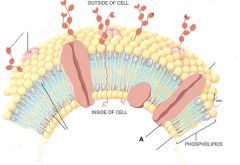
What is A?
|
Protein Receptor
|
|
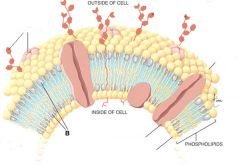
What is B?
|
Chelsterol
|
|
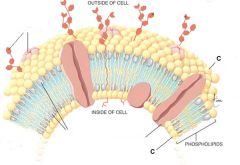
What is C?
|
Hydrophilic Polar Head
|
|
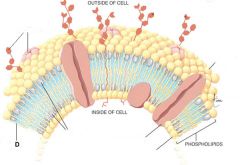
What is D?
|
Hydrophobic fatty acid tail
|
|
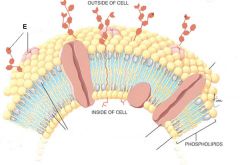
What is E?
|
Glycolipids
|
|
|
The 2 main channel proteins are?
|
Carbohydrates and Proteins
|

